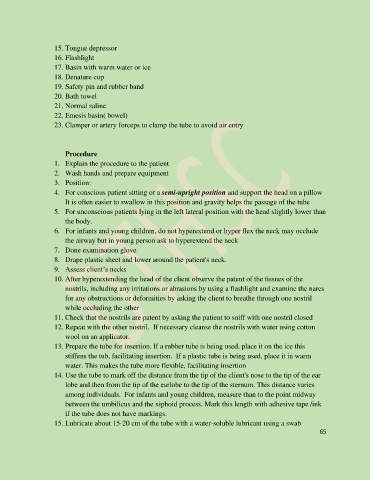Page 79 - Demonstrating skill coppysaved colored-converted
P. 79
15. Tongue depressor
16. Flashlight
17. Basin with warm water or ice
18. Denature cup
19. Safety pin and rubber band
20. Bath towel
21. Normal saline
22. Emesis basin( bowel)
23. Clamper or artery forceps to clamp the tube to avoid air entry
Procedure
1. Explain the procedure to the patient
2. Wash hands and prepare equipment
3. Position:
4. For conscious patient sitting or a semi-upright position and support the head on a pillow
It is often easier to swallow in this position and gravity helps the passage of the tube
5. For unconscious patients lying in the left lateral position with the head slightly lower than
the body.
6. For infants and young children, do not hyperextend or hyper flex the neck may occlude
the airway but in young person ask to hyperextend the neck
7. Done examination glove
8. Drape plastic sheet and lower around the patient's neck.
9. Assess client’s necks
10. After hyperextending the head of the client observe the patent of the tissues of the
nostrils, including any irritations or abrasions by using a flashlight and examine the nares
for any obstructions or deformities by asking the client to breathe through one nostril
while occluding the other
11. Check that the nostrils are patent by asking the patient to sniff with one nostril closed
12. Repeat with the other nostril. If necessary cleanse the nostrils with water using cotton
wool on an applicator.
13. Prepare the tube for insertion. If a rubber tube is being used, place it on the ice this
stiffens the tub, facilitating insertion. If a plastic tube is being used, place it in warm
water. This makes the tube more flexible, facilitating insertion
14. Use the tube to mark off the distance from the tip of the client's nose to the tip of the ear
lobe and then from the tip of the earlobe to the tip of the sternum. This distance varies
among individuals. For infants and young children, measure than to the point midway
between the umbilicus and the xiphoid process. Mark this length with adhesive tape /ink
if the tube does not have markings.
15. Lubricate about 15-20 cm of the tube with a water-soluble lubricant using a swab
65

